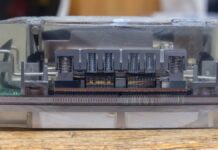Intel Xeon Bronze 3204 Market Positioning
Thes chips are not released in a vacuum instead, they have competition on both the Intel and AMD sides. When you purchase a server and select a CPU, it is important to see the value of a platform versus its competitors.
Intel Xeon Bronze 3204 v. Intel Alternatives
There is a single reason to use the Intel Xeon Bronze 3204 versus other alternatives: cost when performance does not matter. If you look at the core counts over the past seven years in the ~$213 price segment, they have stayed relatively similar.

Likewise, although 1.9GHz is an improvement, as are the IPC increases we have seen for five generations, there is a clear charter to not improve clock speeds too much in this segment.

To us, that is fine. These are really “light the platform” parts which are meant to sell a functional server at a low cost. In that platform, one now gets more features along with some basic expansion of platform capabilities to 6 channels of DDR4 and 48 PCIe 3.0 lanes versus the older Xeon E5 models.
If all you need is a CPU to run a low-end storage box or have a physical server for a certain low-compute always-on service, the Intel Xeon Bronze 3204 works well. If you need more than that, we suggest all of our users start with the Intel Xeon Silver 4208. Better yet, one can start with the Silver 4210. See our upcoming reviews on those chips.
Intel Xeon Bronze 3204 v. AMD EPYC Alternatives
AMD needs to be the competition here. In our Channel Cobblers and a Hole in the AMD EPYC Line article, we outline why AMD does not have but needs a competitive part. We are simply going to direct your attention there.
Intel Xeon Bronze 3204 v. Arm and Power Alternatives
IBM Power is a different segment than the Intel Xeon Bronze 3204. Although it can go lower in performance, that is not to compete with the Bronze series. Currently, the Intel Xeon Bronze 3204 one may assume is under siege from Arm. Arm architectures have a specific aptitude in this power/ performance envelope.
Simply put, the main reason someone buys an Intel Xeon Bronze 3204 is that it is a LGA 3647 x86 part, not because of performance. Intel has more power efficient and faster parts in this segment, but they are not LGA 3647.
Final Words
If you simply need an inexpensive x86 processor to go in a modern LGA 3647 server and boot the platform, the Intel Xeon Bronze 3204 is a great fit. One can still hook up SAS controllers, a substantial amount of RAM, a few NVMe SSDs, NICs and build basic storage machines or servers that run DNS or authentication services. One use we have heard of recently is as extra quorum nodes for small clusters where low-cost single-socket Intel Xeon Bronze servers can be installed simply to increase the cluster node count in what would be 2 to 5 node clusters.
For our readers, we have typically seen a very small price premium to move from the Bronze to Silver series at major OEMs. Our suggestion is to buy a Silver 4208 or 4210 instead to add compute capacity and single threaded performance. It is easier to get the right part from the outset than having to upgrade a machine in a data center.




I bought a pair of 3104 for less than $500 and put on an new exotic Supermicro board. This was our first dual CPU attempt. We figured if happy we replace with a pair of Silvers for $1500 to $2500 the pair. Well the performance from the 3104 pair is so good we have not done that. That is besides the ability to use everything instead of restrictions on one CPU boards. I figure the same for a 3204 pair. I agree a single 3204 is useless.
We are now looking to put in another Supermicro dual CPU board but want to take advantage of the 2900 memory available but it seems to be only available on Gold class. What does Serve the home say about that?
That AVX-512 // GROMACS is fascinating. Sure looks more than 200MHz.
These are also good if you want a physical directory server and stuff like that if you’re got an org that doesn’t want to virtualize
Nice reviews, thanks for that!
Just one point: Instead of using GROMACS to judge AVX performance, why don’t you use Intels Linpack benchmark for that? Although I know GROMACS makes heavy use of AVX instructions, you just cannot say if there are two or just one FMA unit available. (Also with linpack you should not make any claims about it but as it is the one (and only) benchmark that can saturate the FMA units…but do not forget to measure ‘real’ frequencies at the same time e.g. with turbostat on llnux. ) Probably the most interesting benchmark would be to use Agner Fog’s tools:
https://www.agner.org/optimize/
He has the skills to really measure instruction throughput and stuff like that.
Personally I think a Linpack/DGEMM benchmark would be better than just using GROMACS to measure AVX performance.
And now intel tells us to turn HT off because of security issues (which makes these CPU’s atleast 25% slower).
RIDL and Fallout: MDS attacks, Attacks on the newly-disclosed “MDS” hardware vulnerabilities in Intel CPUs.
GROMACS works a lot faster on GPU’s, just check puget for performance metrics.
Any chance to do a proper power consumption test? TDP is not an accurate metric.
Our city has frequent blackouts, so we use custom UPS linked to car battery, (so that the machine can survive the blackout without shutdown) so lower wattage is always better for us.